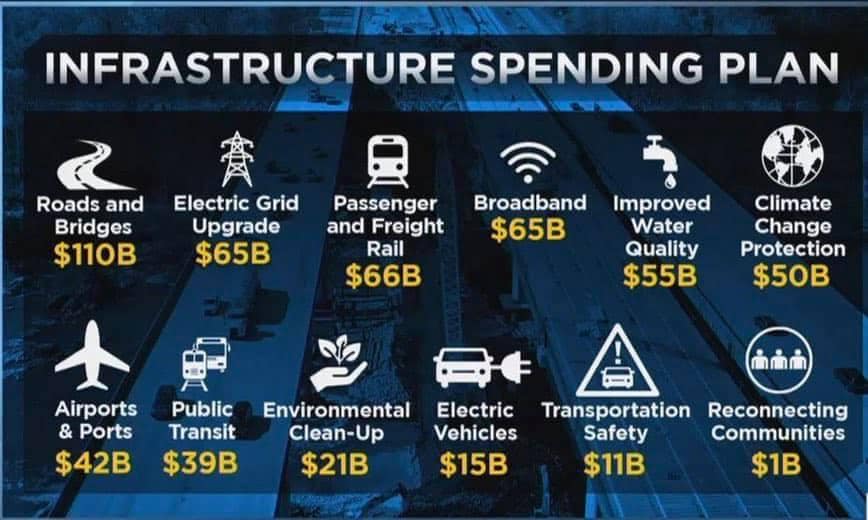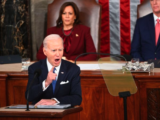Staff Report –
WASHINGTON, D.C. — Timing, technical details and the Biden administration’s old fashioned way of using media could be to blame for why the historic and future significance of the $1.2 trillion Infrastructure Investment and Jobs Act got lost in the mediasphere and the meta verse over the weekend.
Depending on what else is going on in the news and on social media, that could change next week when President Joe Biden holds a signing ceremony after Congress returns from a short recess.
The $1.2 trillion infrastructure plan sets aside billions of dollars to build new roads, repair bridges, fix ports, build out the nation’s rail system, fix water systems to get rid of lead pipes, upgrade the electric power grid and expand broadband internet access in rural areas and low income urban centers, just for starters.
“The new law promises to reach almost every corner of the country,” according to a sparsely shared story from the Associated Press. “It’s a historic investment that the president has compared to the building of the transcontinental railroad and Interstate Highway System” in the 1950s.
The White House is projecting that the investments will add about 2 million jobs per year over the next decade, no small thing.
The House passed the bill Friday night on a bipartisan basis with 228 yes votes to 206 nays. The Senate had already passed the bill on a 69-30 vote in August, also on a bipartisan basis. So much for criticism of Biden that he can’t accomplish things by fostering bipartisanship. That has dominated the discussion in the news and on social media for months, and it won’t go away overnight. It still dominates news stories and social media posts, which seem to linger in the meta verse on Facebook and Google search results and never go away.
Thirteen House Republicans voted for the bill, giving Democrats more than enough votes to overcome a handful of defections from liberal, progressive members of their party. Six Democrats voted no on the bill, including Alexandria Ocasio-Cortez and Jamaal Bowman of New York, Cori Bush of Missourii, Ilhan Omar of Minnesota, Ayanna Pressley of Massachusetts and Rashida Tlaib of Michigan.
The 13 Republicans who voted for the bill included Don Bacon of Nebraska, Brian Fitzpatrick of Pennsylvania, Andrew Garbarino, John Katkoof, Tom Reed and Nicole Malliotakis of New York, Anthony Gonzalez of Ohio, Adam Kinzinger of Illinois, David B. McKinley of West Virginia, Christopher H. Smith and Jeff Van Drew of New Jersey, Fred Upton of Michigan and Don Young from Arkansas.
BID Summary
Transportation: Roads, Bridges, Trains, Electric Cars
The bill allocates $110 billion to upgrade the nation’s aging highways, roads and bridges and create thousands of good paying jobs.
Data shows that 173,000 total miles or about 280,000 kilometers of America’s highways, major roads and 45,000 bridges are in poor condition and need fixing.
“The $40 billion set aside for bridges is the single largest dedicated bridge investment since the construction of the national highway system,” sources say.
The $39 billion for public transit allocated in the bill would expand rail transportation systems, improve accessibility for people with disabilities and provide dollars to state and local governments to buy zero-emission and low-emission buses. The U.S. Department of Transportation estimates that the current repair backlog is more than 24,000 buses, 5,000 rail cars, 200 stations and thousands of miles of track and power systems.
To reduce Amtrak’s maintenance backlog, which has worsened since Superstorm Sandy nine years ago, the bill provides $66 billion to improve the Northeast Corridor (457 miles, 735 km) and other routes. It’s less than the $80 billion Biden asked for, but it would still be the largest federal investment in passenger rail service since Amtrak was founded 50 years ago. Biden is famous in part for commuting by Amtrak from Delaware to Washington during his time in the U.S. Senate, so he’s a huge supporter of train travel.
The bill spends $7.5 billion for electric vehicle charging stations across the country, which are critical to accelerating the use of electric vehicles to help curb climate change and provide jobs in automobile manufacturing, where many car and truck companies are pivoting to building electric cars and trucks. The bill provides $5 billion for the purchase of electric school buses and hybrids as well, reducing the reliance on school buses that run on diesel fuel and pollute the environment.
Internet Access
The legislation’s $65 billion for broadband access would aim to improve internet service for rural areas, low-income families and tribal communities. Most of the money would be made available through grants to states.
Modernizing the Electric Power Grid
To protect against the power outages that have become more frequent in recent years, especially in places like Texas, California and New York, the bill would spend $65 billion to improve the reliability and resiliency of the country’s electric power grid and provide jobs in the building trades, many union jobs. It would also boost carbon capture technologies and more environmentally friendly electricity sources like clean hydrogen.
Airports
The bill would spend $25 billion to improve runways, gates and taxiways at airports and to improve terminals. It would also improve aging air traffic control towers.
Water and Wastewater
The legislation spends $55 billion on water and wastewater treatment infrastructure. It includes $15 billion to replace lead pipes and $10 billion to address water contamination from polyfluoroalkyl substances, chemicals that were used in the production of Teflon and have also been used in firefighting foam, water-repellent clothing and many other products.
Funding the Plan
The five-year spending package would be paid for by tapping $210 billion in unspent COVID-19 relief aid and $53 billion in unemployment insurance aid some states have halted, along with an array of smaller pots of money, like petroleum reserve sales and spectrum auctions for 5G services.
To learn more about it, see the White House Website on the Infrastructure Plan
Early Reaction
In early reaction to the bill’s passages, House Majority Leader Steny H. Hoyer, the Democrat from Greenbelt, Maryland, said the major legislation includes “the largest infusion of funding for America’s infrastructure in our nation’s history.”
“It is now on its way to President Biden to be signed into law, allowing $1.2 trillion worth of investments to begin flowing to states and communities across our country that will rebuild, upgrade, and expand roads, bridges, highways, and other critical infrastructure, which will create millions of jobs and expand economic opportunity,” he said. “It will vastly expand access to high-speed internet in underserved areas, including rural and inner-city communities. Moreover, it will promote the more rapid adoption of clean-energy technologies and improve our resilience against climate change.”
The House also took a major step toward enacting the Build Back Better Act, he said, the social policy bill demanded by the progressive caucus in the House.
“I am confident that the House will advance this transformational legislation soon and make fully paid-for, generational investments in children, families, communities, and addressing the climate crisis. United in our common commitment to govern For the People, Democrats are delivering on our promises with bold actions to create good jobs and make opportunities more accessible and equitable,” he said. “Now that we have enacted long-overdue investments in our nation’s physical infrastructure, we will work tirelessly to complete our work to enact the rest of the Build Back Better agenda to make sure working families can achieve real economic security.”
There was also early reaction from the U.S. Department of the Interior, which put out a press release about it on Saturday.
Secretary of the Interior Deb Haaland applauded the passage of the Bipartisan Infrastructure Deal (BID). She called it “a once-in-a-generation investment that will help communities tackle the climate crisis while creating good-paying union jobs, advancing environmental justice, and boosting local economies. The legislation is the largest investment in the resilience of physical and natural systems in American history.”
The BID contains several provisions that fund Interior Department initiatives and benefit the communities served by the department.
“The Bipartisan Infrastructure Deal is an historic down payment on ensuring that future generations have clean air, drinkable water, fertile soil, and an overall quality of life that is currently threatened by the worsening climate crisis,” Haaland said. “As our communities bear the brunt of intensifying droughts, wildfires, flooding, and legacy pollution, the BID’s investments will be crucial to ensuring local, state, and Tribal communities have the resources they need to bolster climate resilience and protect natural areas. The Interior Department stands ready to implement this transformational investment in our country as quickly as possible.”
The legislation makes historic investments in bolstering climate resiliency, she said, including an $8.3 billion investment in water and drought resilience.
“There is an urgent need to minimize the impacts of drought and develop a long-term plan to facilitate conservation and economic growth,” she said. “Our shared priority is to build resilient communities and protect our water supplies for people and the natural environment.”
The BID’s investments will fund water efficiency and recycling programs, rural water projects, WaterSMART grants, and dam safety to ensure that irrigators, Tribes, and adjoining communities receive adequate assistance and support.
Other Funds
There’s $1.5 billion in the bill for wildfire resilience.
“Climate change is driving the devastating intersection of extreme heat, drought, and wildland fire danger across the United States, creating wildfires that move with a speed and intensity previously unseen,” she said. “The BID will help better prepare communities and ecosystems against the threat of wildland fire by making historic investments in forest restoration, hazardous fuels management and post-wildfire restoration activities across America’s national parks, forests and grasslands, as well as investing in our federal firefighters.”
There’s $1.4 billion in the bill for ecosystem restoration and resilience.
“Climate change is impacting our natural ecosystems in ways never seen before,” she said. “Changing temperatures are affecting water supplies, altering wildlife habitat and migration patterns, introducing new pests and diseases, and causing devastation from wildland fire. The BID makes a critical investment in the resilience and restoration of America’s lands, including funding for stewardship contracts, ecosystems restoration projects, invasive species detection and prevention, and native vegetation restoration efforts.”
There’s $466 million in the bill for tribal climate resilience and infrastructure.
“As the effects of climate change continue to intensify, Indigenous communities are facing unique climate-related challenges. Flooding, erosion, permafrost subsidence, sea level rise, and storm surges are presenting existential threats to communities’ economies, infrastructure, livelihoods, and health,” she said. “The BID’s investments will support community-led transitions for the most vulnerable Tribal communities, including climate adaptation planning, ocean and coastal management planning, capacity building, and relocation, managed retreat, and protect-in-place planning for climate risks. It will also help fund construction, repair, improvement, and maintenance of irrigation and power systems, safety of dams, water sanitation, and other facilities in Tribal communities.”
The legislation also invests in supporting and protecting communities by spending $16 billion in legacy pollution clean-up projects.
“The Department is committed to helping working families, often in rural and Tribal communities, who face hazardous pollution, toxic water levels, and land subsidence both during mining and long after coal companies have moved on,” she said. “The BID makes historic investments to plug orphan wells and reclaim abandoned mine lands, which will help communities eliminate dangerous conditions and pollution caused by past coal mining. These funds support vitally needed jobs for coal communities by funding projects that close dangerous mine shafts, reclaim unstable slopes, improve water quality by treating acid mine drainage, and restore water supplies damaged by mining.”
The plan invests $2.5 billion in Indian water rights settlements.
“Water is a sacred resource, and water rights are crucial to ensuring the health, safety and empowerment of Tribal communities,” Haaland said. “The Department is committed to upholding our trust responsibilities and delivering long-promised water resources to Tribes, certainty to all their non-Indian neighbors, and a solid foundation for future economic development for entire communities dependent on common water resources. The BID’s historic investments will help the Department fulfill settlements of Indian water rights claims.”
___
If you support truth in reporting with no paywall, and fearless writing with no popup ads or sponsored content, consider making a contribution today with GoFundMe or Patreon or PayPal.
Before you continue, I’d like to ask if you could support our independent journalism as we head into one of the most critical news periods of our time in 2024.
The New American Journal is deeply dedicated to uncovering the escalating threats to our democracy and holding those in power accountable. With a turbulent presidential race and the possibility of an even more extreme Trump presidency on the horizon, the need for independent, credible journalism that emphasizes the importance of the upcoming election for our nation and planet has never been greater.
However, a small group of billionaire owners control a significant portion of the information that reaches the public. We are different. We don’t have a billionaire owner or shareholders. Our journalism is created to serve the public interest, not to generate profit. Unlike much of the U.S. media, which often falls into the trap of false equivalence in the name of neutrality, we strive to highlight the lies of powerful individuals and institutions, showing how misinformation and demagoguery can harm democracy.
Our journalists provide context, investigate, and bring to light the critical stories of our time, from election integrity threats to the worsening climate crisis and complex international conflicts. As a news organization with a strong voice, we offer a unique, outsider perspective that is often missing in American media.
Thanks to our unique reader-supported model, you can access the New American journal without encountering a paywall. This is possible because of readers like you. Your support keeps us independent, free from external influences, and accessible to everyone, regardless of their ability to pay for news.
Please help if you can.
American journalists need your help more than ever as forces amass against the free press and democracy itself. We must not let the crypto-fascists and the AI bots take over.
See the latest GoFundMe campaign here or click on this image.
Don't forget to listen to the new song and video.
Just because we are not featured on cable TV news talk shows, or TikTok videos, does not mean we are not getting out there in search engines and social media sites. We consistently get over a million hits a month.
Click to Advertise Here
















